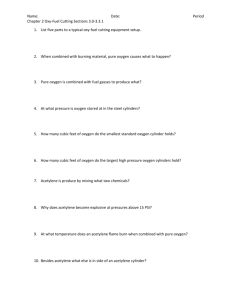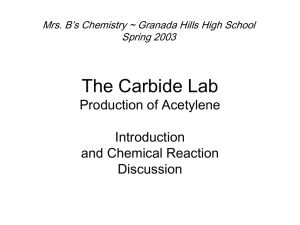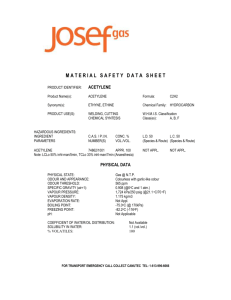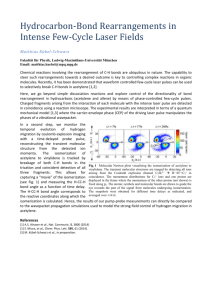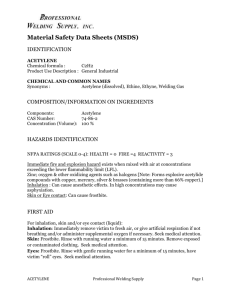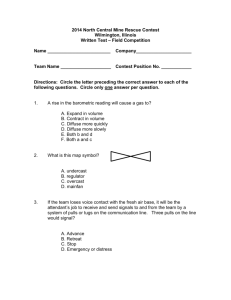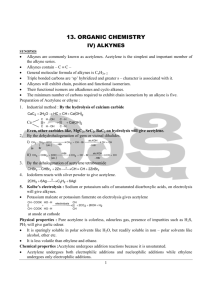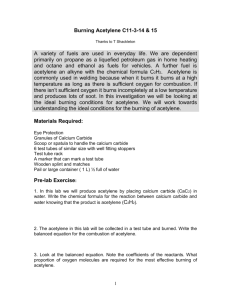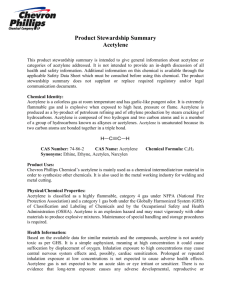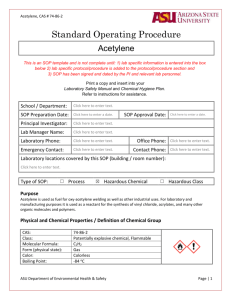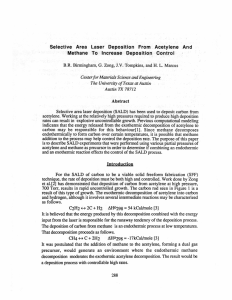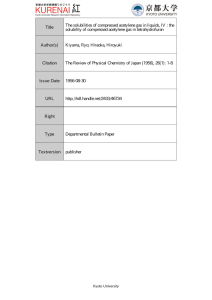Calcium Carbide Lab
advertisement
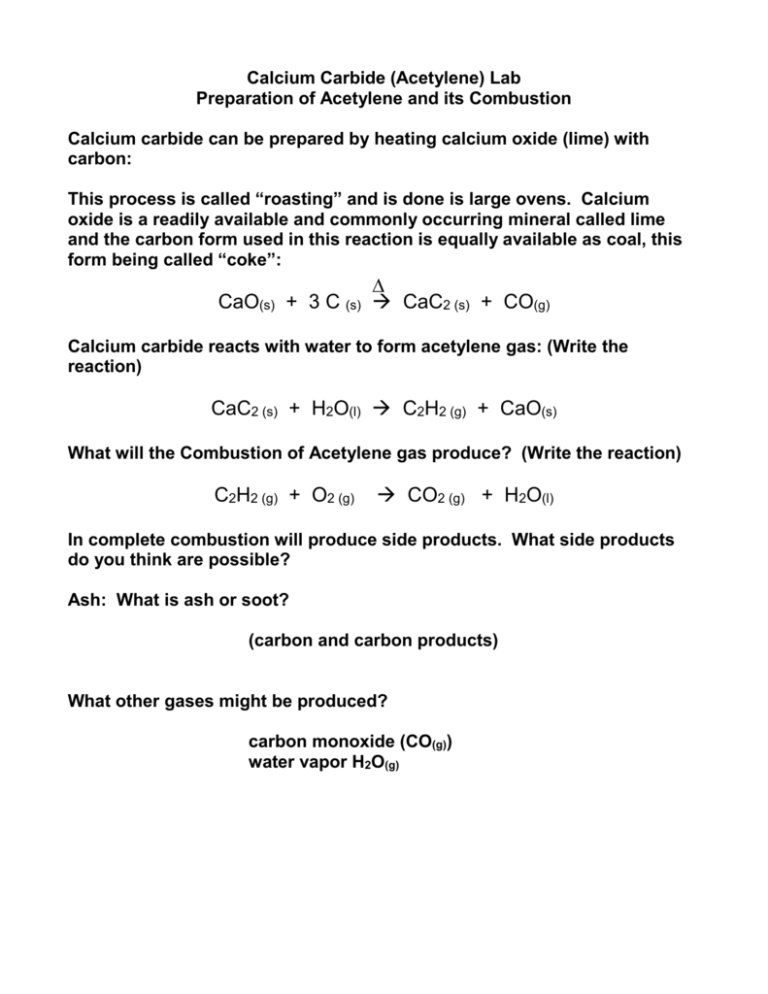
Calcium Carbide (Acetylene) Lab Preparation of Acetylene and its Combustion Calcium carbide can be prepared by heating calcium oxide (lime) with carbon: This process is called “roasting” and is done is large ovens. Calcium oxide is a readily available and commonly occurring mineral called lime and the carbon form used in this reaction is equally available as coal, this form being called “coke”: CaO(s) + 3 C (s) CaC2 (s) + CO(g) Calcium carbide reacts with water to form acetylene gas: (Write the reaction) CaC2 (s) + H2O(l) C2H2 (g) + CaO(s) What will the Combustion of Acetylene gas produce? (Write the reaction) C2H2 (g) + O2 (g) CO2 (g) + H2O(l) In complete combustion will produce side products. What side products do you think are possible? Ash: What is ash or soot? (carbon and carbon products) What other gases might be produced? carbon monoxide (CO(g)) water vapor H2O(g) The following is the edited text of a winning essay, enhanced with diagrams. The bibliography has been excluded. The Chemistry Hall of Fame is a registered trade mark of York University. http://www.chem.yorku.ca/hall_of_fame/essays97/acetylene/acetylen.htm A Winning Essay Acetylene by Kelly O'Hara, Collège Notre-Dame, Sudbury Acetylene was discovered in 1836 in England by E. Davy. Its commercial production was made in the U.S. by T.L. Wilson. Acetylene is an odourless, colourless gas produced by a process that uses two abundant and inexpensive materials: limestone and coal. Calcium carbonate (limestone) is first converted to calcium oxide, and coal is converted to coke. These two products react producing calcium carbide, which reacts with water forming acetylene gas, C2H2. Unlike other hydrocarbons, acetylene can also be produced directly by the reaction of coal and hydrogen at high temperatures. Many hydrocarbons, including acetylene, can be produced through oil-based technology, but since oil reserves are diminishing, acetylene may once again be the raw material for many commercial products. Acetylene's chemical and physical properties account for many of its uses. Its flame is highly luminous, thus it was used in miners', bicycle, automobile and street lamps. Its combustion in pure oxygen produces the highest achievable flame temperature, over 3300 °C, releasing 11,800 J/g, allowing it to weld, cut, braze and solder metals in various environments: from great depths underwater to the extreme cold of Alaska. The oxy-acetylene torch is used to repair ships underwater, to construct bridges, pipelines, dams, tunnels, buildings and to reinforce concrete. http://www.teachers.yourhomework.com/mrsb/torch.jpg Acetylene's structure is The triple bond undergoes addition reactions. Hydrogen chloride added to acetylene produces vinyl chloride which polymerises forming polyvinyl chloride used to make pipe, siding, rain gutters, molded bottles, electrical insulation, floor and wall coverings, upholstery, garden hoses and waterproof clothing. Hydrogen cyanide added to acetylene produces acrylonitrile used as an intermediate in the production of nitrile rubbers, acrylic fibers, and insecticides. Acetic acid added to acetylene forms vinyl acetate used as an intermediate in polymerized form for films and lacquers. Alcohol added to acetylene yields vinyl ether used as an anaesthetic. Water added to acetylene produces acetaldehyde used as a solvent and flavouring in food, cosmetics and perfumes. Chlorine adds to acetylene forming 1,2-dichloroethene (DCE) used as a solvent for fats, phenol and camphor. Formaldehyde added to acetylene reacts producing 1,4-butynediol which can be hydrogenated to 1,4-butanediol used as a chain extender for polyurethane. These resins include urethane foams for cushioning material, carpet underlay and bedding, insulation in refrigerated appliances and vehicles, sealants, caulking and adhesives. Acetylene reacts with carbon monoxide and alcohol forming acrylate esters used in the manufacture of Plexiglass and safety glasses. Acetylene can polymerize forming polyacetylene. The delocalized electrons of the alternating single and double bonds between carbon atoms give polyacetylene its conductive properties. Doping of polyacetylene makes this polymer a better conductor. Polyacetylene is used in rechargeable batteries that will probably be used in electric cars and may also replace copper wires in aircraft because of its light weight. Polydiacetylene is also a polymer of the future. It behaves as a photoconductor and will probably be used for time-temperature indicators or monitoring of irradiation. Based on its availability, its many uses and prospective uses, acetylene is definitely special. Air Composition The sea-level composition of air (in percent by volume at the temperature of 15 ° C and the pressure of 101325 Pa) is given below. Name Nitrogen Symbol N2 Percent by Volume 78.084 % Oxygen O2 20.9476 % Argon Ar 0.934 % Carbon Dioxide CO2 0.0314 % Neon Ne 0.001818 % Methane CH4 0.0002 % Helium He 0.000524 % Krypton Kr 0.000114 % Hydrogen H2 0.00005 % Xenon Xe 0.0000087 % Source: CRC Handbook of Chemistry and Physics by David R. Lide, Editor-in-Chief 1997 Edition
